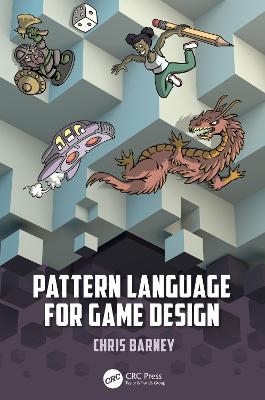
Pattern Language for Game Design
CRC Press (Verlag)
978-0-367-63395-0 (ISBN)
Chris Barney’s Pattern Language for Game Design builds on the revolutionary work of architect Christopher Alexander to show students, teachers, and game development professionals how to derive best practices in all aspects of game design. Using a series of practical, rigorous exercises, designers can observe and analyze the failures and successes of the games they know and love to find the deep patterns that underlie good design. From an in-depth look at Alexander’s work, to a critique of pattern theory in various fields, to a new approach that will challenge your knowledge and put it to work, this book seeks to transform how we look at building the interactive experiences that shape us.
Key Features:
Background on the architectural concepts of patterns and a Pattern Language as defined in the work of Christopher Alexander, including his later work on the Fifteen Properties of Wholeness and Generative Codes.
Analysis of other uses of Alexander’s work in computer science and game design, and the limitations of those efforts.
A comprehensive set of example exercises to help the reader develop their own patterns that can be used in practical day-to-day game design tasks.
Exercises that are useful to designers at all levels of experience and can be completed in any order, allowing students to select exercises that match their coursework and allowing professionals to select exercises that address their real-world challenges.
Discussion of common pitfalls and difficulties with the pattern derivation process.
A guide for game design teachers, studio leaders, and university departments for curating and maintaining institutional Pattern Languages.
An Interactive Pattern Language website where you can share patterns with developers throughout the world (patternlanguageforgamedesign.com).
Comprehensive games reference for all games discussed in this book.
Author
Chris Barney is an industry veteran with more than a decade of experience designing and engineering games such as Poptropica and teaching at Northeastern University. He has spoken at conferences, including GDC, DevCom, and PAX, on topics from core game design to social justice. Seeking degrees in game design before formal game design programs existed, Barney built his own undergraduate and graduate curricula out of offerings in sociology, computer science, and independent study. In pursuit of a broad understanding of games, he has worked on projects spanning interactive theater, live-action role-playing game (LARP) design, board games, and tabletop role-playing games (RPGs). An extensive collection of his essays of game design topics can be found on his development blog at perspectivesingamedesign.com.
Christopher Barney is an industry veteran, with over a decade of experience designing and engineering games like Poptropica and teaching at Northeastern University. He has spoken at conferences including GDC, DevCom, and PAX on topics from core game design to social justice. Seeking degrees in game design before formal game design programs existed, Chris built his own undergraduate and graduate curricula out of offerings in sociology, computer science, and independent study. In pursuit of a broad understanding of games, he has worked on projects spanning interactive theater, LARP design, board games, and tabletop RPGs. An extensive collection of his essays of game design topics can be found on his development blog at perspectivesingamedesign.com.
Section I Introduction
Chapter 1 ◾ Introduction 3
Section II Background
Chapter 2 ◾ Background on A Pattern Language by Christopher Alexander 21
Chapter 3 ◾ Background on the Use of Pattern Languages in Other Fields 29
Chapter 4 ◾ Background on the Use of Patterns in Game Design 35
Section III An Introduction to Patterns in Game Design
Chapter 5 ◾ An Introduction to Patterns in Game Design 53
Chapter 6 ◾ Common Problems in Proposed Patterns 69
Section IV Pattern Exercises
Chapter 7 ◾ Pattern Exercises 77
Chapter 8 ◾ Basic Pattern Exercise 79
Chapter 9 ◾ Structural Pattern Exercises 89
Chapter 10 ◾ Focused Patterns 147
Chapter 11 ◾ Patterns That Break the Mold 185
Section V The Fifteen Properties
Chapter 12 ◾ Taking a Step Back: What We Have Learned So Far 217
Chapter 13 ◾ The “Fifteen Fundamental Properties of Wholeness” in Game Design 219
Section VI Advanced Pattern-Generation Exercises
Chapter 14 ◾ Advanced Pattern-Generation Exercises 241
Section VII Building a Language
Chapter 15 ◾ Connecting Patterns into a Language 313
Chapter 16 ◾ Organizing and Maintaining a Pattern Language 333
Chapter 17 ◾ Creating New Pattern Exercises 375
Chapter 18 ◾ Designing with a Pattern Language 379
Chapter 19 ◾ Teaching Yourself or Students with Pattern Languages 385
| Erscheinungsdatum | 16.01.2021 |
|---|---|
| Zusatzinfo | 49 Halftones, black and white |
| Verlagsort | London |
| Sprache | englisch |
| Maße | 156 x 234 mm |
| Gewicht | 453 g |
| Themenwelt | Kunst / Musik / Theater |
| Mathematik / Informatik ► Informatik ► Theorie / Studium | |
| ISBN-10 | 0-367-63395-7 / 0367633957 |
| ISBN-13 | 978-0-367-63395-0 / 9780367633950 |
| Zustand | Neuware |
| Haben Sie eine Frage zum Produkt? |
aus dem Bereich


